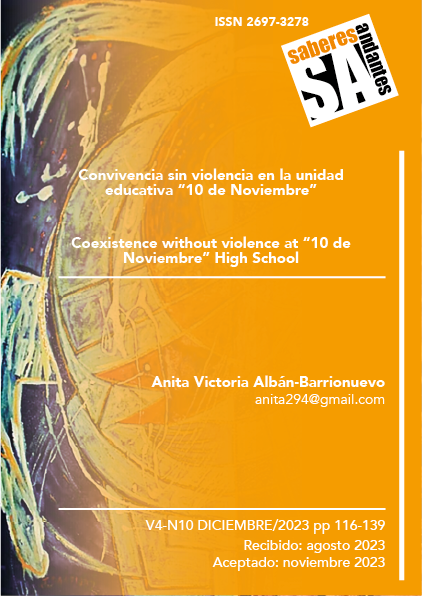Coexistence without violence at “10 de Noviembre” High School
Keywords:
violence, school conflict, coexistence, educational strategy, studentsAbstract
The present work was carried out at "10 de Noviembre" High School, in Guaranda city, province of Bolívar in Ecuador, during the 2022-2023 school year. The aforementioned institution, works at night, giving the possibility for students who work during the day to study at night. As an educator, I consider that my function is not limited to imparting knowledge, it really goes much further, hence it is important to carry out research on these issues related to violence in the educational context, which, if presented, affects the educational community in every way, especially students. The main objective of my research was: Analyze relevant aspects of conflict and school coexistence so that students live in an educational environment of peace, harmony and commitment to conflict resolution, promoting their comprehensive education. I carried out a mixed investigation: documentary and field. The documentary research allowed to consult documents such as: books, websites, etc. The field survey allows direct research to be carried out in the place and time where the phenomenon to be investigated occurs. Also, a descriptive investigation was developed because it sought a characterization of the studied phenomenon. The results determined positive aspects that help a school coexistence free of violence, but also negative aspects that hinder school coexistence in peace and harmony, so it is necessary to develop a plan of sensitization activities to combat the negative and achieve an educational context free of violence.
Downloads
References
Delgado, P. (09 de 12 de 2019). Institute for the Future of Education. La teoría del aprendizaje social: ¿qué es y cómo surgió?: https://observatorio.tec.mx/edu-news/teoria-del-aprendizaje-social/
Fuéguel, C. (2000). Interacción en el aula. Barcelona: Praxis.
Función Ejecutiva del Ecuador. (22 de 02 de 2023). Registro Oficial: Órgano de la República del Ecuador. https://www.registroficial.gob.ec/index.php/registro-oficial-web/publicaciones/suplementos/item/18204-segundo-suplemento-al-registro-oficial-no-254
Grajales, T. (27 de 03 de 2000). Google Académico. Tipos de Investigación: https://cmapspublic2.ihmc.us/rid=1RM1F0L42-VZ46F4-319H/871.pdf
Hernández, R., Fernández, C., & Baptista, P. (2014). Google Académico. Selección de la muestra: http://metabase.uaem.mx/xmlui/bitstream/handle/123456789/2776/506_6.pdf
Lara, H. (2015). Agresión entre iguales. Teorías sobre su origen y soluciones en los centros educativos. Redalyc, 31(2), 24. https://doi.org/677-699
Ministerio de Educación. (2022). Recursos Educativos. https://recursos.educacion.gob.ec/red/modelo-educativo-nacional/
Ministerio de Educación del Ecuador. (28 de 07 de 2022). Ley Orgánica de Educación Intercultural. https://educacion.gob.ec/wp-content/uploads/downloads/2022/12/Ley-Organica-Educacion-Intercultural.pdf
Organización Mundial de la Salud. (2020). Prevención de la violencia en la escuela: manual práctico. https://apps.who.int/iris/bitstream/handle/10665/331022/9789240000254-spa.pdf
Unicef. (10 de 05 de 2017). 1 de cada 5 estudiantes ha sufrido de acoso escolar en el Ecuador . https://www.unicef.org/ecuador/comunicados-prensa/1-de-cada-5-estudiantes-ha-sufrido-de-acoso-escolar-en-el-ecuador
Unidad Educativa "10 de Noviembre". (05 de mayo de 2020). Código de Convivencia. Guaranda, Bolívar, Ecuador.

Published
How to Cite
Issue
Section
License
Copyright (c) 2023 Anita Albán Barrionuevo

This work is licensed under a Creative Commons Attribution-NonCommercial-ShareAlike 4.0 International License.
1. Derechos de autor
Las obras que se publican en Saberes Andantes están sujetas a los siguientes términos:
1.1. Saberes Andantes, conserva los derechos patrimoniales (copyright) de las obras publicadas, favorece y permite la reutilización de las mismas bajo la licencia Licencia Creative Commons 4.0 de Reconocimiento-NoComercial-CompartirIgual 4.0, por lo cual se pueden copiar, usar, difundir, transmitir y exponer públicamente, siempre que:
1.1.a. Se cite la autoría y fuente original de su publicación (revista, editorial, URL).
1.1.b. No se usen para fines comerciales u onerosos.
1.1.c. Se mencione la existencia y especificaciones de esta licencia de uso.








